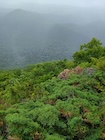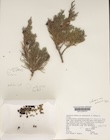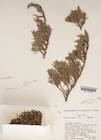Conservation Status

Juniperus davurica
Pallas (1789)
Common names
Dahurian juniper (Adams 2014).
Taxonomic notes
Type: Russia, Amur River, P. S. Pallas s.n. (lectotype BM). There are variant spellings of the epithet, including dauurica and dahurica. Juniperus section Sabina; sister species include J. sabina, the J. chinensis complex, the J. virginiana complex, and J. semiglobosa. Many authorities treat this as a variety of J. sabina, but molecular evidence places it intermediate between J. sabina var. sabina, the J. virginiana complex, and the J. chinensis complex, differing by 20-25 mutations from each of those groups (Adams and Schwazbach 2012). J. davurica and J. sabina are also separable on the basis of morphology, and have largely disjunct distributions respectively east and west of about 100 degrees longitude. There are three varieties, though they are sufficiently distinct that they might be better treated as subspecies:
Juniperus davurica var. arenaria (E.H. Wilson) R.P.Adams (Rehder and Wilson 1928, Adams and Schwarzbach 2012). Type: China, Qinghai Lake, on high dunes, elev. 3350 m, Sept. 1925, a shrub 0.3 m tall, J.F. Rock 13346. Synonymy:
- Juniperus chinensis L. var. arenaria E.H. Wilson (Rehder and Wilson 1928);
- Juniperus arenaria (E.H. Wilson) Florin 1948;
- Juniperus sabina var. arenaria (E.H.Wilson) Farjon (2001); and
- Juniperus sabina subsp. arenaria (E.H.Wilson) Silba 2006.
Juniperus davurica var. davurica. Syn. J. sabina var. davurica (Pall.) Farjon 2001; with this exception, there are many other synonyms, as listed by POWO.
Juniperus davurica var. mongolensis (R.P.Adams) R.P.Adams (Adams and Schwarzbach 2012). Syn. Juniperus sabina var. mongolensis R.P.Adams (Adams and Schwarzbach 2006).
Description
Dioecious evergreen procumbent shrubs. Bark purplish-brown, exfoliating in thin strips. Twigs ca. 1 mm diameter, densely arranged. Leaves both needle-like and scale-like. Needle-like leaves loosely arranged, linear-lanceolate, 4-6 mm long, adaxially concave with broad white stomatal bands, abaxially arched and obtusely ridged, apex acuminate or acute. Scale-like leaves densely arranged, 1-3 mm long, abaxial surface with a central, elliptic or oblong gland. Pollen cones not described; pollen shed in spring. Seed cones borne on curved twigs, when mature dark brown or bluish-purple, glaucous, irregularly globose, 4-6 × 6-8 mm, holding (1-)2-4 seeds. Seeds ovoid, 3-5 mm long, slightly flattened, apex acute to obtuse (Adams 2014).
Adams (2014) provides the following key to discriminate J. davurica from J. sabina, and to discriminate the varieties:
| 1a. |
Both scale-like and needle-like leaves appear on mature plants, interspersed on each twig, but occasionally one leaf type predominates. |
J. davurica var. davurica |
| 1b. |
Needle-like leaves found only on juvenile plants or at the tips of rapidly growing twigs; otherwise all leaves are scale-like. |
2. |
| 2a. |
Shrubs to 1 m tall, growing in rocky areas, seed cones globose with 1-3 seeds, each seed with an acute tip tapering to a globose base. |
J. sabina |
| 2b. |
Prostrate, or shrubs to 1 m tall, growing in sandy areas, seed cones with 1-4 seeds, each seed with an obtuse tip and an ellipsoid or globose base (1-seeded cones may have seeds with an acute tip). |
3. |
| 3a. |
Seed cones mostly 2-lobed, (1-)2(-4) seeds per cone, seeds with an acute tip that resembles a duck bill, smallest twigs radially distributed around lateral branches. |
J. davurica var. arenaria |
| 3b. |
Seed cones mostly globose, 2-4 seeds per cone, seeds flattened with an obtuse tip, smallest twigs growing from upper side of lateral branches. |
J. davurica var. mongolensis |
Distribution and Ecology
The distribution of this species is generally not well known, both because it has not been widely recognized and because of the political and logistical difficulties involved in traveling to and through its habitat. The elevations, climate, and ecological associations seem not to have been described at all, though its northerly, high-elevation, central Asian distribution indicates that it must be tolerant of low precipitation and very low temperatures. The range is very imperfectly known, but is described as follows (Adams 2014):
- Var. arenaria: China: N Gansu, Nei Mongol?, Shaanxi?. Typically found on very sandy soils.
- Var. davurica: N China, N Mongolia, Russia; generally east of 100° longitude.
- Var. mongolensis: North-central Mongolia.
Because of the general lack of information about J. davurica and its varieties, its conservation status would probably be assessed as "Data Deficient" under IUCN protocols. Due to its very large range and relative lack of threats, var. davurica may well be "Least Concern", but not enough is known about the distributions of vars. arenaria and mongolensis to develop even very rough estimates of their areas of occurrence or of occupancy.
Remarkable Specimens
No data as of 2025.01.04.
Ethnobotany
Adams (2014) reports no known uses.
Observations
No data as of 2025.01.04.
Remarks
The epithet is from Dauriya, an old Russian name for the area currently represented mostly by Mongolia, the Amur River basin, and Heilongjiang province in China.
Citations
Adams, Robert P. 2014. Junipers of the World: The Genus Juniperus. Fourth edition. Trafford Publishing. Brief versions of the descriptions are available online at Adam's website, www.juniperus.org.
Adams, Robert P., and Andrea E. Schwarzbach. 2006. A new variety of Juniperus sabina from Mongolia: J. sabina var. mongolensis. Phytologia 88(2):179-185.
Adams, Robert P., and Andrea E. Schwarzbach. 2012. Taxonomy of the multi-seeded, entire leaf taxa of Juniperus, section Sabina: sequence analysis of nrDNA and four cpDNA regions. Phytologia 94:350–366.
Adams, Robert P., Andrea E. Schwarzbach, and Alexander N. Tashev. 2016. Chloroplast capture in Juniperus sabina var. balkanensis R. P. Adams and A. N. Tashev, from the Balkan peninsula: A new variety with a history of hybridization with J. thurifera. Phytologia 98(2):100–108.
Farjon, Aljos. 2001. World Checklist and Bibliography of Conifers, 2nd ed. The Royal Botanic Gardens, Kew.
L'Herbier Virtuel. 1998. http://www.lenet.fr/vegetal/herbier/herbier2.html, accessed 1998.10.05, now defunct.
Pallas, P. S. 1789. Flora Rossica seu stirpium Imperii Rossici per Europam et Asiam indigenarum descriptiones et icones 1(2):13, t.55. Available: Biblioteca Digital, accessed 2025.01.04.
Rojo, J., and P. Uribe-Echebarría. 2008. Juniperus herragudensis, otro nuevo
híbrido de la provincia de Castellón. Mainhardt 60:83–85.
Rehder, Alfred and Ernest H. Wilson. 1928. Enumeration of the ligneous plants collected by J. F. Rock on the Arnold Arboretum Expedition to Northwestern China and Northeastern Tibet. Journal of the Arnold Arboretum 9:4-20 (p.20). Available: Biodiversity Heritage Library, accessed 2025.01.04.
See also
Elwes and Henry 1906-1913 at the Biodiversity Heritage Library. This series of volumes, privately printed, provides some of the most engaging descriptions of conifers ever published. Although they only treat species cultivated in the U.K. and Ireland, and the taxonomy is a bit dated, still these accounts are thorough, treating such topics as species description, range, varieties, exceptionally old or tall specimens, remarkable trees, and cultivation. Despite being over a century old, they are generally accurate, and are illustrated with some remarkable photographs and lithographs.
Farjon (2005) provides a detailed account, with illustrations.





